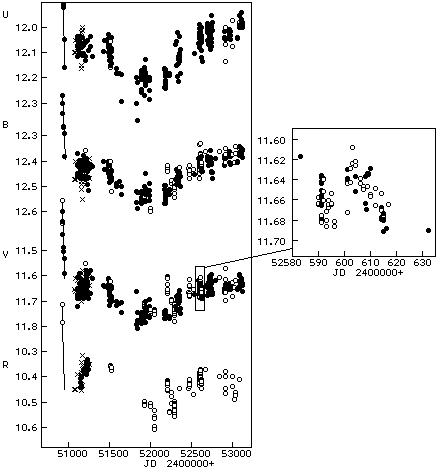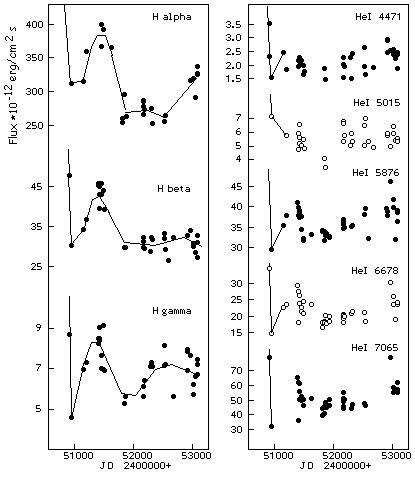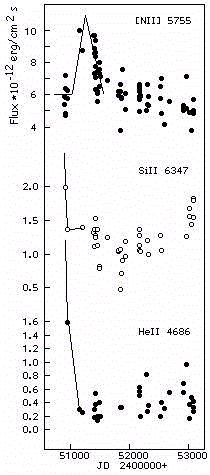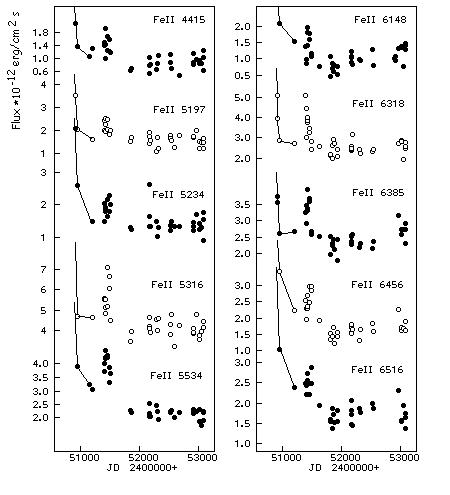Spectroscopic and photometric studies of X-ray
transient and B[e] star CI Camelopardalis in 1998-2004.
Barsukova, E.A., Borisov, N.V., Burenkov, A.N.(Special
Astrophysical Observatory, Russian Academy of Sciences);
Goranskij, V.P., and Metlova, N.V. (Sternberg Astronomical
Institute, Moscow University)
Report to the conference VAC-2004 "Horizons of the Universe" held
in Moscow on June 3-10, 2004.
Strong ourburst of CI Cam in X-ray, optical and radio
waves happened on 1998 April 1. First observations of S-shaped
relativistic jets taken with VLA were revised and disproved
by Rupen M.P., et al. (New Views on Microquasars,
ed. P.Dourouchox et al., Center for Space Physics, Kolkata,
p.221, 2002), and the system was excluded from the lists
of microquasars. Due to absence of the excess in the hard
X-rays, rapid fluctuations of the radiation, and periodic
pulsations in X-rays, the existence of a black hole or a
neutron star as a compact companion is unlikely. The compact
companion may be a white dwarf, and the outburst may be a
result of thermonuclear runaway of the matter accumulated
on its surfice due to accretion from stellar wind of nearby
B star.
UBVR-photometry. Slow light variation with the minimum
at JD 2452000 and amplitude of 0m.15-0m.20
is observed after the outburst. If this variation is periodic
then its period is more than 1500 days. As a result of 28 day
monitoring carried out in the late 2002
we find the regular light oscillations with amplitude of
0m.05 and period of about 19.4 day (Fig. 1).
The period of 11.7 day by A.S.Miroshnichenko
(AsAp. Trans. V.6, p.251, 1995) was not confirmed by
new data.

Figure 1. UBVR light curves of CI Cam in a quiet state.
Black circles are the photoelectric observations, open
circles are CCD observations, crosses are literature data.
Medium resolution spectroscopy. Wide absorption wings
of the hydrogen photospheric lines of B star are seen in the
blue spectrum taken with BTA (Fig. 2). Using the estimates
of the width of H-delta and H-eta lines
the spectrum B4 III-IV is revealed. The classification
of B star as a supergiant is now excluded. With
E(B-V) = 0m.90, the distance to CI Cam is estimated
as 1.1-1.9 kpc, and the luminosity Mv in the range
between -1m.2 and -2m.4.

òÉÓ. 2. Spectrum of CI Cam in the blue region taken
with BTA on 2004 February 18. Wide absorption wings of
photospheric Balmer lines of B star are well seen.
New observations of emission line intensities do not give
yet the reliable confirmation for periodic or cyclic
behaviour, and then fail to confirm the irradiation
effect on a possible cool companion. The lines of cool companion
are not found in the spectrum. Our last observations do
not confirm the symB[e] classification for CI Cam.
The brightening of majority of lines near JD 2451400 may
be explained by response of gaseous envelope on the X-ray outburst.

Figure 3. Intensity variations of emission lines of CI Cam.
(Data were taken with 1-m Zeiss reflector +
UAGS spectrograph at SAO RAS).
Decay of the outburst is marked with a solid line. Hydrogen lines
followed the photometric cycle during the first three years.
HeI lines showed rapid fluctuations of intensity.

Figure 3 (continued). Intensity variations of emission lines
of CI Cam.
During the outburst [NII] 5755A emission line had the intensity
characteristic of the quiescence. And it brightened with the time
delay of about 300 days relative to maximum of the outburst.
HeII 4686A emission had maximum amplitude of the
outburst, by 300 times, as compared with other line emissions.
But now it is very faint.

Figure 3 (continued). Intensity variations of emission lines
of CI Cam. The behaviour of different FeII lines after the
outburst is shown. Majority of lines demonstrate recurring
brightening after the large outburst, and follow the photometric
cycle in the same way as hydrogen lines.





